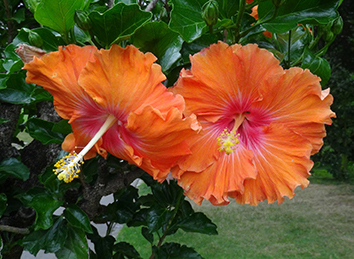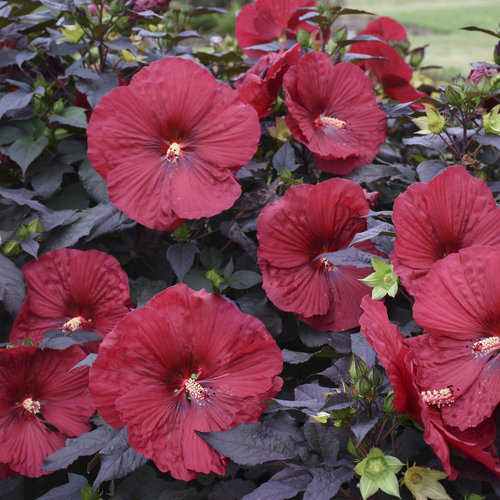Types of Hibiscus - Hibiscus Wears Many Hats
What’s in a name? When it comes to Hibiscus, quite a lot. This common name encompasses several hundred species of tropical plants, hardy perennials and woody shrubs. Which type of hibiscus are you growing in your garden? This handy primer will help you spot the differences, identify which kind you have, and learn how to care for them.
In late summer and early fall, when all three types of hibiscus commonly grown in the U.S.—tropical, perennial and shrub form--are in bloom, eye popping pictures of gorgeous hibiscus flowers start swirling around the internet in abundance. People describe them with common names like dinner plate hibiscus, rose mallow, clown hibiscus, china rose, rose of Sharon, althea, and many other invented names.
The one thing they all have in common name is the word “Hibiscus”, which is actually the botanical Latin name for the genus, though we’ve popularized the word in English. Think of it like the word hors d’oeuvre, which is the French word we’ve popularized for appetizer. Other than their genus, these three types of hibiscus have drastic differences that are important to understand.
Tropical Hibiscus
Tropical hibiscus, botanically known as Hibiscus rosa-sinensis, are commonly grown outdoors in frost-free climates like southern Florida where they are used in foundation plantings and planted as hedges. In the north, they are often sold as houseplants that can be moved outdoors in summer and back inside for winter. You may see them sold in grafted tree forms as well.
Tropical hibiscus flowers typically grow 4-6 inches across in shades of orange, yellow, red, pink, and multicolor. Purple and white forms are less common. Their petals are often quite ruffled and many feature an eye of a contrasting color.
This plant thrives in hot, humid climates and full sun. If you grow tropical hibiscus in a place where temperatures dip below 50°F, you’ll need to bring it indoors until summerlike temperatures return. The move from outdoors to indoors may trigger plant shock and leaf drop. After a short resting period, it should leaf out again.
Perennial Hibiscus
Perennial forms of hibiscus, commonly known as rose mallow, are derivatives of native wildflowers that grow naturally in sunny, swampy areas from Minnesota to Florida, zones 4-9. Several species can be found in the wild, the most common of which are Hibiscus moscheutos and Hibiscus coccineaus. Most of the varieties you’ll find at your local garden center are hybrids of these native species. These hybrids, like the Summerific® series, have been selected by plant breeders for their shorter, denser habit (native species can reach up to 10 feet tall), more flowers, and a fuller flower form.
Perennial hibiscus is a hardy perennial that should be grown in the ground outdoors, given plenty of space as they typically mature to 3-5 feet tall and wide in just a few years. It makes a fabulous focal point in the landscape or perennial garden. It cannot be grown indoors as a houseplant like tropical hibiscus. Full sun and consistent water are essential for growing perennial hibiscus successfully. Like the shrub form, its leaves are slow to reappear in spring but it fills out quickly once it begins.
Perennial hibiscus bear very large, 6-9 inch flowers. This trait has earned them the nickname “dinner plate hibiscus”. They range in color from red to pink, lavender, white, or a combination of these colors. Many have a contrasting eye. If the hibiscus in your garden is orange or yellow, it is not this type of perennial hibiscus as these colors do not exist in these species.
Deer typically pass perennial hibiscus by, but hummingbirds and pollinating bees are attracted to its colorful flowers. Rabbits may nibble on the new growth but the foliage will quickly grow out of their reach.
In the fall, leave the thick, bare stems of perennial hibiscus standing. They will help to catch the fallen leaves which will insulate the crown of the plant during winter. In early spring, use a strong pair of loppers to prune the stems back to about 6 inches and remove any debris that is caught amongst its branches. The plant will regrow from underground, not from last year’s stems.
Shrub Hibiscus
Shrub forms of hardy hibiscus, botanically known as Hibiscus syriacus, are commonly called rose of Sharon or althea. Like tropical hibiscus, they have woody stems and a bushy form. However, their flowers appear in greater abundance, measure 2-3 inches across, can be single or double, and come in shades of pink, purple, blue and white. Some cultivars have a contrasting eye. Like perennial hibiscus, you won’t find a rose of Sharon with yellow or orange flowers. Butterflies and hummingbirds are attracted to their blooms, particularly single forms, but deer typically pass them by.
Rose of Sharon is a hardy shrub that should be grown in the ground outdoors in full sun in zones 5-9. It cannot be grown indoors as a houseplant like tropical hibiscus. Most varieties grow quite large, reaching heights of up to 12 feet, though the dwarf Lil’ Kim® series matures to just 3-4 feet tall. Rose of Sharon typically grows taller than wide, with some like Purple Pillar® maxing out at just 2-3 feet wide. This shape makes them ideal for use along a fence line, as a screen, or as a focal point near the entryway of your home.
In northern climates, keep this shrub watered consistently through late fall so it is well-hydrated going into the winter months when it will lie dormant. In warmer climates, maintain average moisture levels as long as the plant is actively growing. If pruning is needed for shaping purposes, it should be done in early spring.
While reseeding can become a nuisance in some climates, newer rose of Sharon cultivars like Sugar Tip®, the Chiffon® series, and Satin® series set little to no viable seed. Look for these varieties if reseeding could become an issue in your garden.
Want to learn more? Find all Proven Winners® Hibiscus here.
Patent Info: Summerific® 'Cranberry Crush' Hibiscus USPPAF CanPBRAF, Ruffled Satin® Hibiscus syriacus USPP26222, Lil' Kim® Hibiscus syriacus USPP19547 CanPBR3399, Purple Pillar® Hibiscus syriacus USPP25568 CanPBRAF, Sugar Tip® Hibiscus syriacus USPP20579 CanPBR3582









